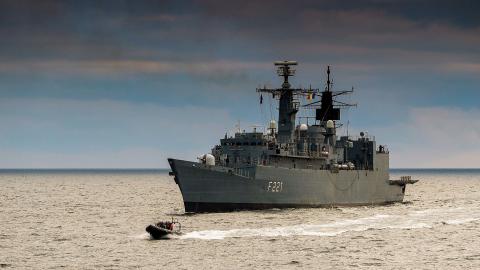Leaders on NATO’s eastern flank routinely warn that if Putin succeeds in Ukraine, “they are next.” While many think any such Russian action would be in the Baltics and Putin remains obsessed with Poland, Moscow has been more aggressive in the Black Sea region (BSR). NATO should expect more Russian probes along its eastern flank, including even a test of Article 5, but focus more on the Black Sea region.
Danish Defense Minister Troels Lund Poulsen warns that Russia could attack NATO in 3-5 years. Polish BBN chief Jacek Siewiera suggests three years, NATO Military Committee Chair Rob Bauer 3-7 years, German Defense Minister Boris Pistorius 5-7 years, and UK Defence Secretary Grant Shapps within the next five years. Former Bulgarian Prime Minister Nikolai Denkov spoke of 3-10 years. Estonia’s foreign intelligence service has spoken of a military confrontation “within the next decade.” The German army has even exercised for an attack on the Suwalki Corridor as early as 2025.
These warnings do not specify what kind of attack might be expected or potential targets, but Moscow has been pursuing a pinprick policy against NATO for years. It has violated Romanian territory numerous times since February 2022, even if these cases cannot be proven to have been intentional. In July 2023, a cargo ship was damaged after Russia attacked the Ukrainian port of Reni on the Danube. Fragments of Iranian drones have been found on Romanian territory five times. With Moscow escalating its attacks on Ukrainian infrastructure and Danube ports so close to Romania, more such incidents cannot be excluded. In March 2023, Russian aircraft even forced down an American MQ-9 Reaper drone over the Black Sea.
Russia has also probed repeatedly elsewhere on NATO’s eastern flank. A cruise missile violated Polish airspace in December 2023 for about three minutes, another in March 2024 for 39 seconds. The remains of a KH-55 missile were found near Bydgoszcz, a city halfway across Poland, in April 2023. NATO fighters intercepted Russian aircraft more than 300 times in 2023, mostly in the Baltic but also in the Black Sea region, often with transponders turned off.
These incidents, which look very much like intentional probes by Russia, have several goals: to test NATO responses, to demonstrate that Moscow can violate NATO territory with impunity, to provoke a sense in NATO member states that tough responses could lead to war, and to raise doubt about comments by President Biden, NATO Secretary General Stoltenberg, and others that they “will defend every inch of NATO territory.”
NATO member states have generally interpreted these cases as stray events, “collateral damage,” or “mistakes,” even if the airspace violations are clearly intentional and have met with a NATO response. Affected countries have not pressed NATO to treat them as significant enough for Article 4 or 5 consultations. National governments have also played them down.
But these incidents are continuing, and if any were to become serious enough for an ally to take to the NATO North Atlantic Council (NAC) member states would face the question of whether to respond, and if so how. They also raise the prospect that it may be just a matter of time before Russia tries something more serious. Were allies not to support a resolute NATO response on the grounds that it is “small” or a “mistake,” or even that it might “risk WWIII,” Putin would have deeply undermined Article 5 and weakened the alliance.
Russia is determined to take Ukraine, including the entire northern littoral of the Black Sea, and believes time and momentum are on its side. It has lost so much global standing that Putin may see a test of NATO territory as an opportunity to reset the global strategic balance in one fell swoop. He gravely miscalculated in 2022, but would he roll the dice to strengthen Russia’s strategic position further, especially if NATO member states do not continue to support Ukraine and Russia continues to advance in the land domain? Would Moscow, flush with a sense of victory press onward? Maybe, maybe not, but the United States and NATO must be ready.
First, while this probing phenomenon is in evidence in various places along the Eastern flank, the United States should focus more on the southeast. The United States needs a robust, whole-of-government Black Sea strategy that accounts for the region's long-term strategic importance as well as the likelihood of regional conflict in the short run. Such a strategy should begin with an understanding of the maritime domain’s critical significance in the Eurasian balance of power. It should state explicitly that NATO allies should maintain strategic primacy in the BSR. The goal must be to box out Russia, be able to challenge the Kremlin in its naval near abroad, and bar it from the Levantine Basin. This will limit Russia's influence in Turkey, reduce Iran's access to southeastern Europe, and establish a security infrastructure to prevent Chinese economic and strategic infiltration.
Second, the United States should rely primarily on its NATO partners in the BSR to implement this strategy. The most important ally in this context is Romania, whose geographical position and regional posture are similar to that of West Germany during the Cold War, when it bordered the Iron Curtain separating NATO from the Warsaw Pact. The United States and its allies need a more robust presence in the BSR due to its significance in great power competition, European security, and global strategy.
The Black Sea's limited maritime space and air-land-naval linkages point to the need for a fleet of two to three dozen fast attack vessels armed with anti-ship missiles, supported by land-based strike elements, and supplemented with minelayers capable of disrupting Russian surface combatant deployments while putting Russian bases at risk. A network of sensors is also necessary to track Russian submarines as well as air, naval, and underwater drones, and helicopters with anti-submarine warfare capabilities. The Danube-Black Sea waterway allows for the basing of non-Black Sea state defense capabilities. With U.S. support, this posture will trigger a situation where NATO allies increase their presence on the new line of containment, thus assuming more responsibility for defending Europe.
Third, U.S. strategy needs to be grounded on the understanding that the BSR is both vulnerable and critical for both U.S. and European security in the long term. During the Cold War, Soviet naval forces expanded into the eastern Mediterranean, wielded power in North Africa, and pressed NATO's southern flank. However, NATO possessed a strong European fleet, including U.S. carriers and ally vessels, which could withstand active Soviet action against NATO's southern flank.
This is no longer the case. If Russia were to defeat Ukraine, the Black Sea would again become more of a “Russian lake” and European NATO will become progressively less defensible conventionally. As the BSR is the first battleground in the Russian drive to dominate Eurasia and, by extension – together with Communist China, theocratic Iran, the DPRK and others – the new international system, the United States must ensure the BSR remains under clear and definitive Western influence.














